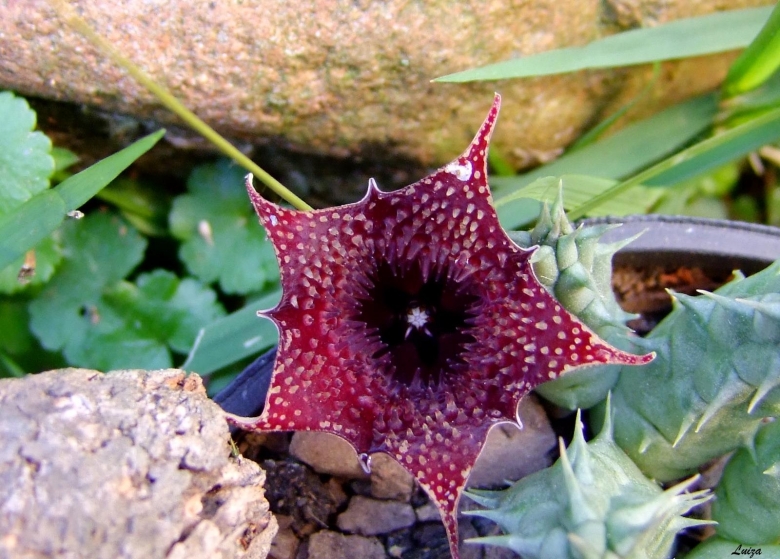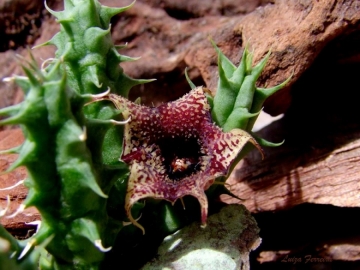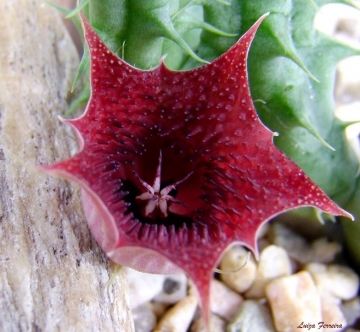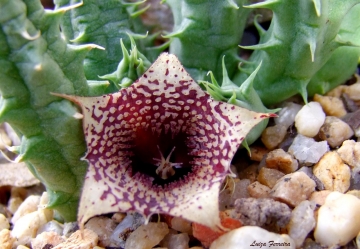
Huernia saudi-arabica Photo by: Luiza Ferreira
Origin and Habitat: Huernia saudi-arabicaSN|28288]]SN|28288]] is found in scattered localities in the Asir (Near Wadi Wej), 25 km SW of Taif. Saudi Arabia.
Type locality: Between Abha and Al Suda; Waterfall beauty spot Country.
Altitude range: Around 1800 metres above sea level.
Habitat and origin: This species grows among rocks on rather barren steep grey rock cliff immediately on right above falls.
Synonyms:
See all synonyms of Huernia saudi-arabica
back
Accepted name in llifle Database:Huernia saudi-arabica D.V.FieldKew Bull. 35(4): 754. 1981 [28 Apr 1981]Synonymy: 2
back
Description: Huernia saudi-arabicaSN|28288]]SN|28288]] is a mottled red and grey-green succulent with crowded five-angled soft-toothed stems to 7 cm high. The wide-opening bell-shaped flowers are about 40 mm wide, deep purplish-red inside with raised whitish-yellow papillae; the blackish centre sometime is basally streaked with fine golden lines. The flowers in many related species emit a distinctive carrion smell in order to attract carrion flies, which are the pollinators, but H. saudi-arabica has little or none of that smell. However the scent of the Huernias from each of the different mountain localities are different, which points to the probablility that there are several species or forms involved in this complex. It is still unclear whether this variable complex is one or several species. There is so much variation even in the same population that most authors choose to lump them together.
Stems: prostrate-decumbent or erect, soft-toothed, tufted, 3-6 cm long, about 1 cm in diameter, 5-angular mottled red and grey-green. Tubercles triangular-subulate up to 8 mm long.
Flowers: From base of younger stem. Pedicel 8-16 mm long. Sepals 8-13 mm long 1.5 mm wide. Corolla inside dark purple, campanulate, 4 cm accross some-times with few small whitish spots or basally with fine golden lines, margin of the tube and lobes occasionally weakly spotted with white, margins of lobes darker. Corolla-lobes slender, triangular, acuminate, 14 mm long, 7-10 mm wide at the base, usually strongly recurved, outside generally smooth, rarely finely roughened, inside glabrous, rarely with fine acute tubercles, limb and lobes wholly dark purple to purplish red, sometimes appearing mottled from the spreading pale bases of the papillae, lobes with a continuous, tuberculate or sometimes papillate-tuberculate, narrow, dark margin and with three prominent veins or sometimes only the midvein prominent. Tube proportionally broad, slightly excavated below the throat papillae, somewhat bowl-shaped, rounded at the base, wholly dark purple or sometimes with a few small, whitish flecks, or some fine gold lines inside densely papillose. Papillae basally whitish-yellow, apically dark, 5 1.5 mm, more or less columnar, obtuse, often compressed. Corona 5.5-6 mm. Outer corona black-purple, lobes 2-2.5 mm long, squarish, apically dentate and finely crenate. Inner corona-lobes 4-4.5 mm long, slightly connivent, upper half divergent, apically glabrous, subulate. Staminal column relatively tall, usually 2 mm long. Pollinia yellow.
Subspecies, varieties, forms and cultivars of plants belonging to the Huernia saudi-arabica group
 Huernia saudi-arabica D.V.Field: flowers bell-shaped to 40 mm wide, deep purplish-red with raised whitish-yellow papillae. Distribution: Asir, SW of Taif. Saudi Arabia.
Huernia saudi-arabica D.V.Field: flowers bell-shaped to 40 mm wide, deep purplish-red with raised whitish-yellow papillae. Distribution: Asir, SW of Taif. Saudi Arabia. Huernia transmutata A.C.White & B.Sloane: possibly a form of H. saudi-arabica Its star-shaped flowers are 2 cm diameter of an astonish intense purple-black colour.
Huernia transmutata A.C.White & B.Sloane: possibly a form of H. saudi-arabica Its star-shaped flowers are 2 cm diameter of an astonish intense purple-black colour.
Bibliography: Major references and further lectures
1) L. C. Leach “A Revision of Huernia R. Br. (Asclepiadaceae)” Aloe, Cactus and Succulent Society of Zimbabwe, 1988
2) Focke Albers, Ulrich Meve “Illustrated Handbook of Succulent Plants: Asclepiadaceae: Asclepiadaceae”, Volume 4 Springer Science & Business Media, 2002
3) Sheila Collenette “An illustrated guide to the flowers of Saudi Arabia” Scorpion, 1985
 Huernia saudi-arabica Photo by: Luiza Ferreira
Huernia saudi-arabica Photo by: Luiza Ferreira Huernia saudi-arabica Photo by: Luiza Ferreira
Huernia saudi-arabica Photo by: Luiza Ferreira TM KSA130c/6 Photo by: Luiza Ferreira
TM KSA130c/6 Photo by: Luiza FerreiraSend a photo of this plant.The gallery now contains thousands of pictures, however it is possible to do even more. We are, of course, seeking photos of species not yet shown in the gallery but not only that, we are also looking for better pictures than those already present.
Read More... Cultivation and Propagation: Huernia saudi-arabicaSN|28288]]SN|28288]] is an easy blooming plant when mature that require moderately watering through the growing season but enjoy plenty of water and some fertiliser in hot weather, this helps them to flower freely. Water more sparingly in winter according to temperatures. But, as with most asclepiads, it is unwise to leave them wet in cold weather. Winter care presents no problems at 5°C with plenty of light. Since roots are quite shallow, use a cactus mix or add extra perlite or pumice to regular soil potting soil. A gritty, very free-draining compost is suitable, and clay pots help the plants to dry out between watering.
Sun Exposure: Partial sun or light shade.
Pest and diseases: Huernias vary in their susceptibility to rotting, but are generally fairly easy to grow, especially if kept pest-free. They are very susceptible to stem and root mealy bugs, and damage from these may well initiate fungal attack. If you do have problems with a stem or with basal rotting, you can reliably isolate the healthy parts, dry them off, and re-root them in moist compost.
Cultural Practices: Re-pot every 2 years
Propagation: Easiest with stem cuttings. Allow cuttings to dry a day before planting. Stems must be laid (Not buried) on gritty compost and will then root from the underside of the stems. It can also be increased from seeds sowing in spring in moist, sandy peat moss.
Potting medium: Since roots are quite shallow, use a cactus mix or add extra perlite or pumice to regular soil potting soil. A gritty, very free-draining compost is suitable, and clay pots help the plants to dry out between watering.














